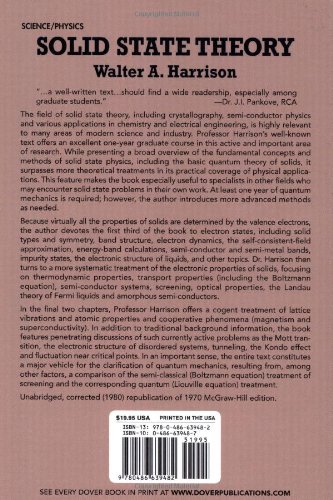

They included such developments as the Coulomb blockade, nanostructures, the quantum Hall effect, and fullerenes, all of which had not yet been discovered at the time of the first edition. It was a prodigious task, as the authors indicate, to bring the book up to date. This expansion makes it definitely a candidate for a contemporary class.

#SOLID STATE THEORY WALTER A HARRISON PDF UPDATE#
An update to Patterson’s 1971 text, it adds a great deal of modern material, nearly doubling the size of the original. But the subjects covered are limited, with most of the content surprisingly centered on questions related to electronic-band structure.īeyond the texts mentioned above, one faces a dazzling array of choices, including Solid-State Physics: Introduction to the Theory by Patterson and Bernard Bailey. Even today, another distinctive possibility for a graduate text is Anderson’s book, because of the author’s unique insight.

For most of us condensed-matter theorists, the first question asked when we consider a property is, “How do we estimate it?” But for Ibach and Lüth, the first question is, “How do we measure it?” That point of view suited my colleague Zhi-Xun Shen when we each taught part of a course at Stanford University: Shen used Ibach and Lüth’s text I used my own. But years later, Harald Ibach and Hans Lüth’s Solid-State Physics: An Introduction to Theory and Experiment (Springer-Verlag, 1991) offered a distinctive approach. The range of material and of approaches covered in the texts seems surprisingly similar. Press, 1964), my own Solid State Theory (McGraw-Hill, 1970), James Patterson’s Introduction to the Theory of Solid State Physics (Addison-Wesley, 1971), Ashcroft and Mermin’s text, and Otfried Madelung’s Introduction to Solid-State Theory (Springer-Verlag, 1978). Ziman’s Principles of the Theory of Solids (Cambridge U. Anderson’s Concepts in Solids: Lectures on the Theory of Solids (W. Inflationary perturbations and the Harrison-Zel'dovich spectrum.In the 1960s and 1970s, a flood of condensed-matter physics books appeared on the scene: Philip W. Non-linear perturbations spherical collapse, virialisation and dark matter halos, an anthropic explanation of the cosmological constant. Window functions and the mass distribution. Nucleosynthesis.ĭensity perturbations sounds waves, the Jeans' instability and perturbations in an expanding space. The hot Big Bang and the radiation dominated era. Chemical potentials and the Bose-Einstein and Fermi-Dirac distributions. The blackbody spectrum and the cosmic microwave background. Inflation.Īn introduction to the Boltzmann distribution and the Maxwell-Boltzmann distribution for the ideal gas. Evidence for dark matter and dark energy. Solutions, including matter, radiation and dark energy dominated universes. Perfect fluids and the continuity equation. The geometry of spacetime and the FRW metric. The cosmological principle: homogeneity and isotropy. Please do email me if you find any typos or mistakes.
#SOLID STATE THEORY WALTER A HARRISON PDF FULL#
The full lecture notes come in around 170 pages. It assumesĪ background in neither general relativity nor statistical mechanics. This is a course on cosmology, aimed at final year undergraduate students.


 0 kommentar(er)
0 kommentar(er)
